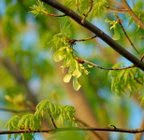My current project is site analysis of the Ruby Grant farm. A quarter section, 160 acres, farm probably owned by the same family since the shots were fired in the air on the land run. The property was donated to OU, who has sold it to the city with the stipulation it become a park. I think it is an absolute treasure. It appears that the eastern red cedar has been kept under control. The property has two creeks, beaver dams and the little river flowing through it. It has remarkable topography considering the surrounding flat prairie. The upland prairies just up out of the lower riparian corridor are shoulder height with grass and Forbes. Black willow, hackberry, cottonwood dominate the canopy while dogwood and coral berry thrive in the understory. Plum and persimmon thickets thrive in the open savanna and sumac and soap berry cling to the edges of the forest in dense colonies. I also suspect native ash and hawthorn to be numbered. I saw a few lone pecans, but no oak or hickory.
The grasses are abundant, and even the farmed fields have native grass creeping into them. I don't know my prairie grasses very well, but I did see little and big bluestem, sedge in the wetlands and large communities of panicum. My wording tonight is hodgepodge and I'm not sticking to common or Latin. I'm tired, and if I don't write it, it won't get recorded.
Birds: hawks, big and small, bluebird with rosy bellies, crowned sparrow, larks, cardinal, wax wing, ducks of a couple species, blue heron, robin, wren?, fly catcher or mockingbird?. Numerous nests.
Beaver, turtle, coyote, grazing deer, rabbit, mice trails.
The Ruby Grant property is a treasure. It has historic farm value, mix grass prairie, savanna prairie views and communities, wetlands, bogs or marshes, ponds, creeks and waterfall. I hope to write more on Ruby Grant, but tonight I'm just going to get up yesterday's pictures. It was really bright at mid-day when I went out, so the pictures are a little bit washed out.
More to come...
I am a landscape architecture student at the University of Oklahoma. This is a place where I can explore links and relationships of landscape and Oklahoma.
Jord Wilson

DAYS TILL GRADUATION
Graduate Student of Master of Landscape Architecture;
Bachelor of Science in Environmental Design;
Minor in Interdisciplinary Principles of the Environment;
College of Architecture;
University of Oklahoma
wanderings
I was born in Oakland California. I grew up in North Central Washington, in the eastern foothills of the Cascades and on the Columbia River. I graduated from a school of 250 students K-12. I didn't attend college until after I was 30, so I brought to school my experience: garden designer, carpenter, concrete worker, florist, greenhouse manager, perennial expert, shrub and tree salesman, bus driver, truck driver, apartment manager and maintenance man. Frequently I worked 3+ jobs a day during my go-get-'em-like-your-killin' -snakes years. So I was well prepared for the vigor's of the University and the initiation rituals of the Architecture department. I graduated from the College of Architecture with a Bachelor of Science in Environmental Design and a minor in Interdisciplinary Perspectives on the Environment. College has allowed me to bundle my many paths into a single and wide corridor. I started my Master of Landscape Architecture program at the University of Oklahoma in the fall of 2006.
bearings
Knowing where I've been is the easy part. Knowing where I come from and where I am going is the challenge. I moved into a little rent house out in the country about 15 miles south of Norman Oklahoma. During my first winter in Oklahoma, I dabbled in some genealogy. I found two great-grandfathers and their families buried within a few miles of my new home. It was not just serendipity that my internal way-finder connected and centered me in the place of my forefathers. I have a deep connection with this place.
compass
The spirit of place.
Present and past human connections influence our lives. Community, family and place are part of our soul. Regional identity is both cultural and physical. The spirit of place is what nourishes our beginings and tethers our world view. It is also that soul and bond that embraces our community.
Technology has allowed us to disregard the environmental aspects of place. The media wants us to believe we are a global society and that our world is getting smaller. Our world gets smaller when we exchange our spirit of place for anothers.
The spirit of place must be unearthed again to regain the comfort of belonging.
BLOG ARCHIVE
-
▼
2007
(137)
-
▼
February
(27)
- Perennial Resource
- Urban Environment
- Landscape Architecture in the movies
- Photoshop
- Stress reliever
- Rough week this week.
- 1951 Ruby Grant Aerial
- Ruby Grant Studio Design and Analysis
- Ruby Grant Park
- The Waste Water/Storm Water Runoff problem
- I'm game--I love words
- Web Rave
- OK-GAP overload
- I want to design an Eco-boulevard
- Echinacea--coneflower
- our strongest prairie feature
- GENIUS LOCI 1.1
- The Chesapeake Boathouse
- Ethanol
- I love this photo
- Thanks for the tip
- George Edward Kessler
- Old OU pictures
- NatureWorks.org
- Oklahoma hunting trip or Art?
- Canadian River
- Consuming School
-
▼
February
(27)
OKLAHOMA
- adobe kuler
- ak river plan
- criterion group
- deq--ok's epa
- myriad gardens
- nature conservancy
- noble foundation
- ok "putting down roots"
- ok biosurvey
- ok climatological survey
- ok greenhouse growers
- ok survey of woodies
- ok tourism
- ok wetlands reference
- okc--will rogers park
- okplanttrees
- ouachita national forest
- pontotoc ridge preserve
- wichita mnts refuge
- wildlife conservation books
PROFESSIONAL
ECOREGIONS
RIPARIAN
SOILS
PHOTOGRAPHY
PLACES
GIS
MY TOWN GOV.
SUNDRY
LEARNING FROM OTHER PARKS
blogline
ENVIRONMENT
URBAN
LANDSCAPE ARCHITECTURE
RURAL
TOOLS
PLANTS


